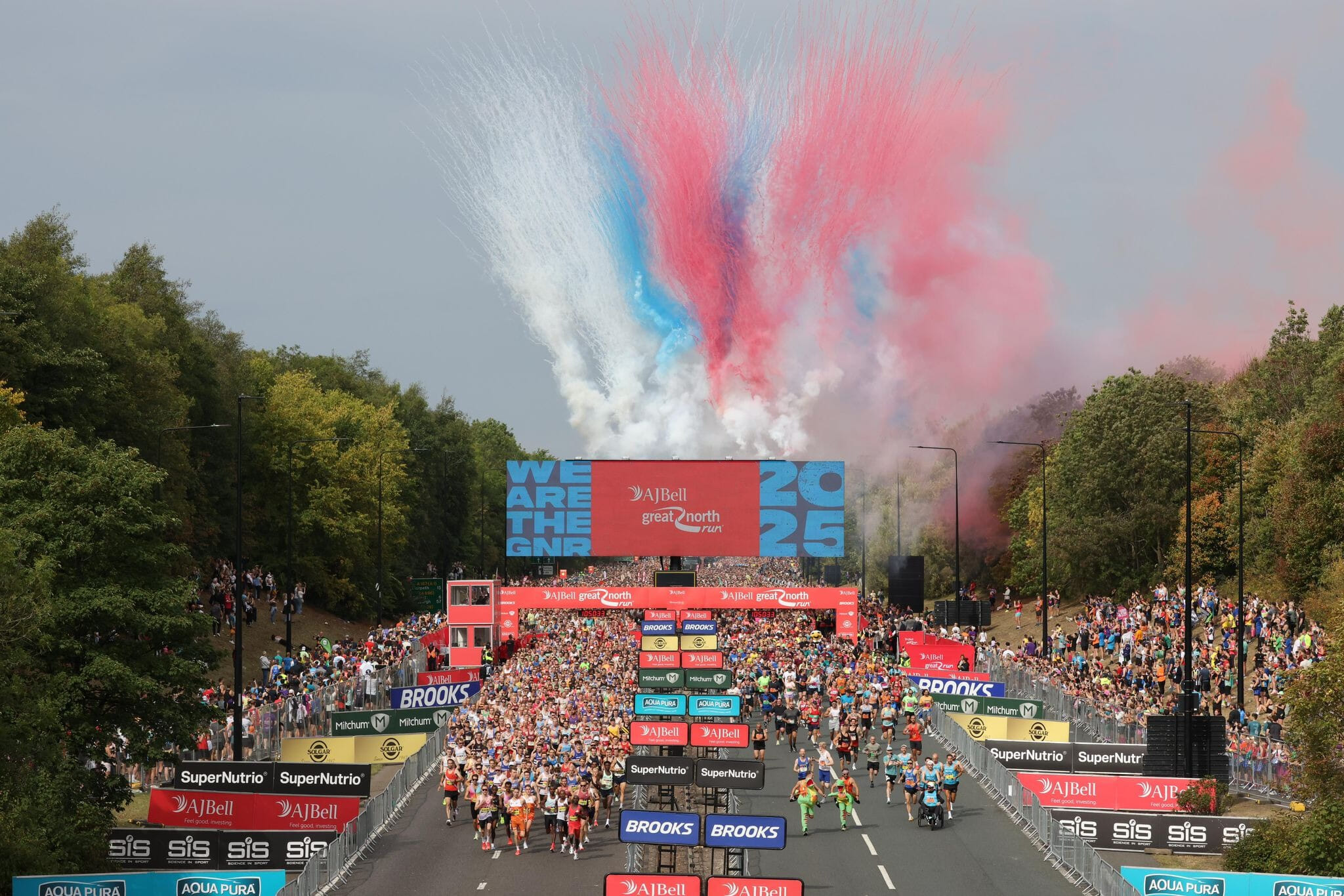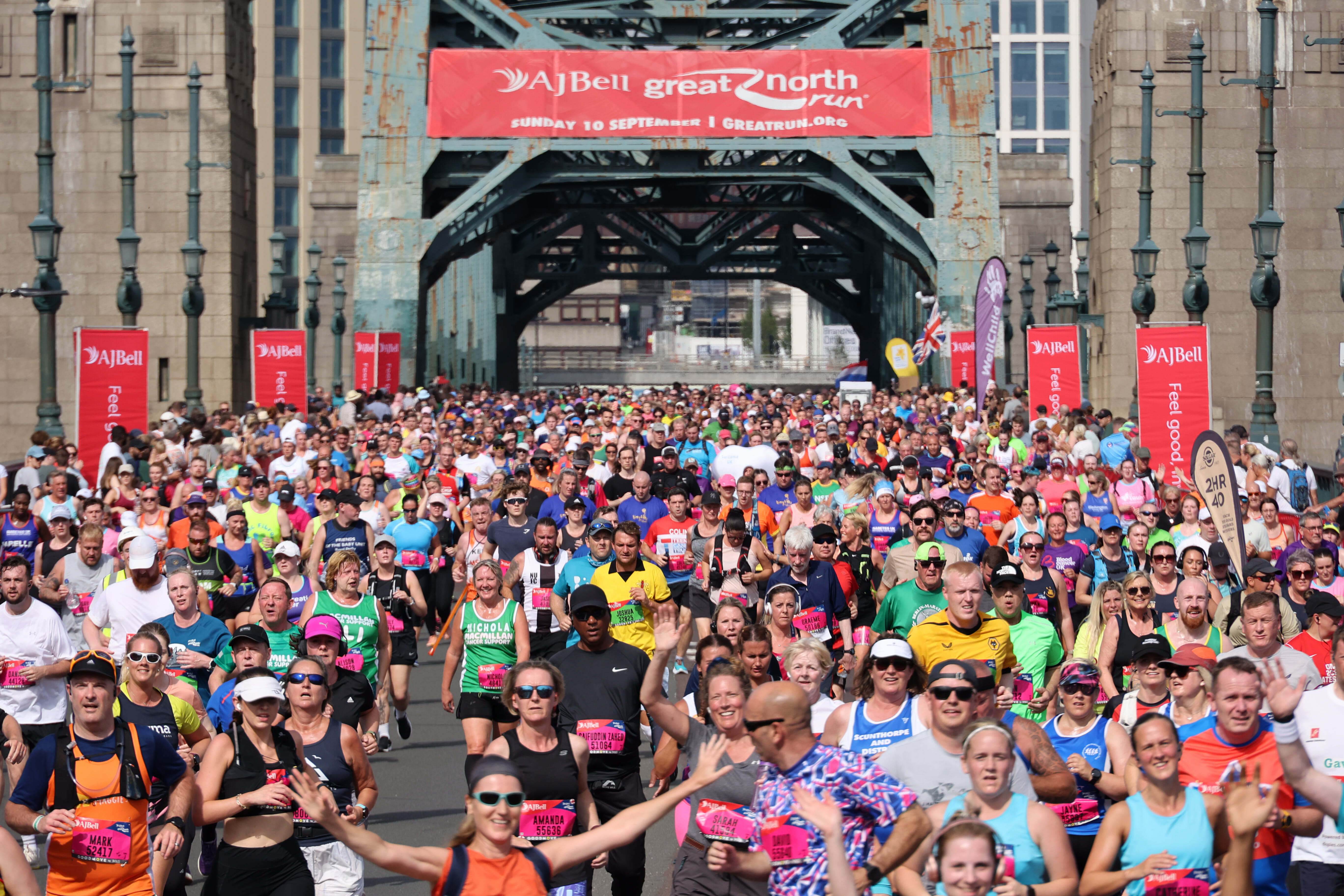Great North Run | Race 101

The Great North Run has earned its place as the world's biggest half marathon and one of the UK's most popular races, with tens of thousands of runners each year crossing the finish line with a grin.
From its hugely popular route, running from city to coast, to innovative new features, this half marathon is an incredible experience from start to finish. Whatever your reason for running, taking part in the Great North Run is a decision that you won't regret.
Making that decision, though, can seem daunting if you've never run a half marathon before or if you have no experience of a major running event. Fortunately, you're not alone - well over one million people have completed the Great North Run since it began and there is enough support out there to help you complete this personal challenge. That's why we've gathered all the essential information about the Great North Run into one place - right here.
At a glance
The race was established in 1981 by former Olympic 10,000m bronze medallist Brendan Foster. In that first year, 12,000 runners descended on Newcastle to run the half marathon route - in 2026, 45 years later, that number exceeds 60,000.
Distance
The Great North Run is a half marathon, so it is 13.1 miles or 21K long. It usually takes runners anywhere between an hour (for the elites) to several hours for those out enjoying themselves and soaking up the great atmosphere. In 2026, the event marks an incredible 45 years, making it one of the oldest half marathons in the UK.
Terrain
Starting on the central motorway, the route has both uphill and downhill sections. Miles 1-2, 5-8 and 12-13.1 are mainly downhill, whereas many runners report that they find miles 8-12 the toughest section - there’s quite a bit of uphill during this four-mile stretch. But don’t worry - there’s music, entertainment and raucous supporters at every turn to help keep you going!
Typical conditions
Newcastle's early September weather can be a surprise, with past races seeing everything from bright sunshine to heavy rain and everything in between. Temperatures usually stay close to average or dip slightly below, but the trick is to expect changeable conditions. Sunny skies greeted runners in 2023 before afternoon rain flooded the finish area, and strong winds posed a challenge for elite times in 2025.
Cut offs
Many people will walk sections of the course, either as part of a run-walk strategy or simply to rest their legs on some of the hillier parts. If you are lucky enough to be part of the Great North Run, there is no pressure to finish it in a particular time or to run the whole thing. Instead, just focus on enjoying the experience. If that means walking some sections, then do it!
The Great North Run strives to help every runner cross the finish line.
Any runner who has not reached the 8-mile point by 14:50 will be escorted onto the pavement by the last runner support team. You will still be assisted in your journey to the finish, but you must remain on the pavement.
There is also the option to board the welfare bus to the finish, or one of the buggies to take you further into the course, allowing you to complete the remainder of the event within the timescale.
On-course support
Frequent drink stations, toilets, medical assistance and showers in warmer weather have got you covered but if it's motivation you need, the reliable north eastern crowds are your best tonic by far!

The Great North Run encompasses some iconic sights, including the Tyne Bridge.
Route highlights
Newcastle start
Your half-marathon journey kicks off on the A167 central motorway with a buzz of energy near Newcastle University and the Town Moor as 60,000 runners get ready and warmed up together. A helpful downhill section lets you find your rhythm right from the start, hitting the road tunnels next, where runners' "Oggy Oggy Oggy!" chants bounce off the walls.
Tyne Bridge
The race's most photographed moment happens at mile 1.5 as runners cross the magnificent Tyne Bridge. This landmark has become the defining image of the Great North Run, with Red Arrows flying overhead. The route continues into Gateshead past the gleaming Glasshouse International Centre for Music and onto the A184 toward Heworth.
Coastal finish in South Shields
First-time runners often describe their excitement at mile 12 when the North Sea comes into view and the finish line draws near! Prince Edward Road offers a flat final mile with crowds cheering you toward the finish line with the refreshing sea breeze in your face.
Start pens and waves
Where to go and when to arrive
When you receive your run number, you'll also be assigned a wave (striped, orange, green or pink). Your wave colour will determine all kinds of essential information, including your arrival time, arrival route, and assembly time.
Due to the size and scale of the event, there are staggered arrival times depending on your wave colour. This is to make sure that there is a steady flow of participants arriving to assemble, and participants aren't waiting too long to cross the start line. Full details and timings will be in your Event Guide.
Toilets and baggage
You'll find toilets and baggage facilities at the Runners' Hubs. Baggage buses will depart at different times depending on wave. You will receive a baggage label to fill in. You will need your run number to access the buses to drop your bags off and collect them at the finish.
Pacing and fuelling
Effort by section
Your run becomes manageable when you break it into three parts. The first 7km takes you downhill, so keep a steady pace without getting swept up in the carnival atmosphere (easier said than done!). Miles 8-12 bring more challenges with the most important uphill sections in the second 7km. Fatigue hits hard in the final stretch—but the sight of the sea at mile 12 and an increase in crowd volume gives you a significant mental lift.
Aid stations
It's possible to drink too much, so only drink when needed however, if hot temperatures are forecast, you may choose to carry your own hydration so that you have constant access.
Common mistakes
Starting off too quickly and weaving through the crowds are two of the key problems facing runners at this event, leading to wasted energy. Try, instead, to keep your pace steady and hang back until the crowds disperse and you can more easily move through.
Travel and accommodation
Public transport
It's all joined-up! The top tip for travelling on event day is to buy a wristband (approx. £6.50). These can be used by runners and spectators to travel all day on event day on Tyne and Wear Metro, any bus service, the Shields Ferry and Northern Trains between Newcastle and Sunderland.
Meeting points
Runners can meet their supporters near Gipsies Green Stadium - simply go to the A-Z banner that matches your runner's surname's first letter.
What to pack
Be prepared to handle everything from Newcastle's changing weather patterns, to recovery after the race.
Checklist for a smooth day
Weather-appropriate gear: breathable clothes, a cap and sun cream for warm weather; a hat and gloves if it's cold and wet. Take an old top to keep you warm at the start line, which will be gathered up and donated to good causes when discarded.
Race essentials: Safety pins for your run number, put Vaseline on areas likely to chafe (groin, underarms, bra band, toes), handle your timing chip carefully - don't bend it.
Post-race necessities: Your drop bag should have warm, dry clothes and food for after you finish.
After the finish
Medals
Every finisher gets a specially-designed medal specific to the year. It’s big, it’s shiny, it’s perfect for showing off to your pals, and it's exciting when the new design is released ahead of the event - so look out for this!
The Great North Run takes place in September each year.